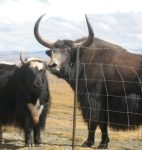Click here for the slideshow accompanying this article
The most universally accepted definition of sustainable development is meeting the needs of the present without compromising the needs of future generations. What has never been clear is how to reach this goal.
Sustainable development can be viewed as an irascible beast with three heads (environmental, cultural and economic); with three sets of eyes looking in different directions, ears hearing contradictory facts and mouths giving contradictory messages. Out of such argumentation, how can the environmental, cultural and economic goals of sustainable development be reached?
Lessons can be found in Tibet, where the government has placed more than 40% of the land area under conservation management with the direct involvement of local people. This conservation process was initiated in March 1989 with the establishment of the Qomolangma (Everest) Nature Preserve (QNNP). The first major protected area in the world managed without wardens, it relies instead on the stewardship of local people. The QNNP was recognised in 1999 by the United Nations as one of the world’s most successful examples of sustainable development. And, in 2004, it was included in the Man and Biosphere (MAB) network of the UN Educational, Social and Cultural Organisation (UNESCO).
In 20 years, the QNNP has:
* Increased population numbers of endangered wildlife, including the snow leopard, wild ass, and blue sheep;
* Improved health, sanitation, education and community-level decision-making for the 318 villages within the protected area through the training of volunteer community-service workers, known as pendebas;
* Developed a network of family-owned hotels to increase local income-generation opportunities;
* Established a well-organised system, using trucks and yaks to remove the trash from the Everest base camp, funded in part with entrance fees;
* Helped to support and restore the ChuWa and Paba temples and Rongbuk monastery;
* Reduced deforestation of fragile mountain juniper through the planting of village tree nurseries and protected the ancient fir forests of the spectacular Gama Valley.
These achievements of nature conservation and socio-economic development required a partnership of government agencies, communities and external actors. The first management plan was accomplished with support from all levels of government, the Chinese Academy of Sciences and the Tibet Academy of Social Sciences. Future Generations China, the international non-government organisation that also supports China’s youth conservation movement Green Long March (绿色长征), played a major role in training local partners, facilitating more than 40 study tours and educational opportunities in conservation and community development. Most importantly, 86,000 local people — living in some of the world’s harshest high-elevation conditions and in two of China’s poorest counties — were called upon to change their behaviours, to stop killing wild animals and stop cutting the juniper.
To encourage conservation stewardship and also to support socio-economic development, Future Generations and the QNNP Management Bureau developed the Pendeba program. “Pendeba” is a new Tibetan word meaning “worker who benefits the village”. Villages within the QNNP nominate a local man and woman to be trained as pendebas and to bring their learning and skills back to their village. Training emphasises basic primary health, sanitation, maintaining tree nurseries and kitchen gardens, conservation concepts and opportunities for income generation. Local people, in extremely remote places, now had a neighbour to whom they could turn for help. To date, 213 pendebas, supported by 20 senior pendebas, have been trained in the QNNP.
The Tibet Department of Science and Technology has since taken notice of the programme as a new direction for sustaining community-based services and linking community development directly with nature conservation. In 2002, the concept was expanded to the Four Great Rivers region, the world’s fourth-largest protected area in south-eastern Tibet, including all of Chamdo and Linzhi prefectures. Alongside Future Generations, the Tibet Department of Science and Technology has trained more than 400 pendebas in animal husbandry, greenhouse construction, kitchen gardens, sanitation, the use of non-timber forest products and primary health. Their story was recently featured by the Canadian Broadcasting Corporation, available here.
Both the QNNP and Four Great Rivers represent a new model of large-scale community-based nature conservation. The core feature of this model is that it defines protected areas using political boundaries (four counties in the case of the QNNP and two prefectures in the case of Four Great Rivers). Conservation is placed in the context of the existing administrative structure, eliminating the need for a separate management structure and dramatically reducing costs. The most important result is that the local people are engaged as partners—each person’s job description (whether farmer, school teacher, village leader or health worker) is redefined to include conservation.
The other significant benefit is that both nature conservation and community-based development adapt to local conditions and environments. In places as ecologically diverse as Tibet, this is essential. Counties adapt their management plans around specific conservation goals and needs. Pendeba training topics and strategies also vary in response to local interests and priorities.
These many lessons from Tibet are being extended now by Future Generations across China through the Green Long March and Model Eco-Communities projects. They are also shared in greater detail in the book Across the Tibetan Plateau: Ecosystems, Wildlife and Conservation, by Robert Fleming, Dorje Tsering, and Liu Wulin.
First published in English by WW Norton in 2007, Across the Tibetan Plateau was recently launched in Tibetan and Chinese editions. The Tibetan version is published by the China Tibetology Publishers, and the Chinese version by the Shanghai Far East Publishers. (The January 2009 books launch was hosted by Future Generations China and the Science and Technology Department of the Tibet Autonomous Region, with assistance from the China Tibetology Research Centre.)
More details are available online at www.future.org and www.futuregenerations.org.cn
Daniel Taylor is president of Future Generations and Future Generations Graduate School. He has been engaged in social change and conservation for four decades, with particular focus on empowering communities and on trans-border conservation. Taylor holds a PhD degree in development planning from Harvard University.
Homepage photo by FutureGenerations/CHINA



